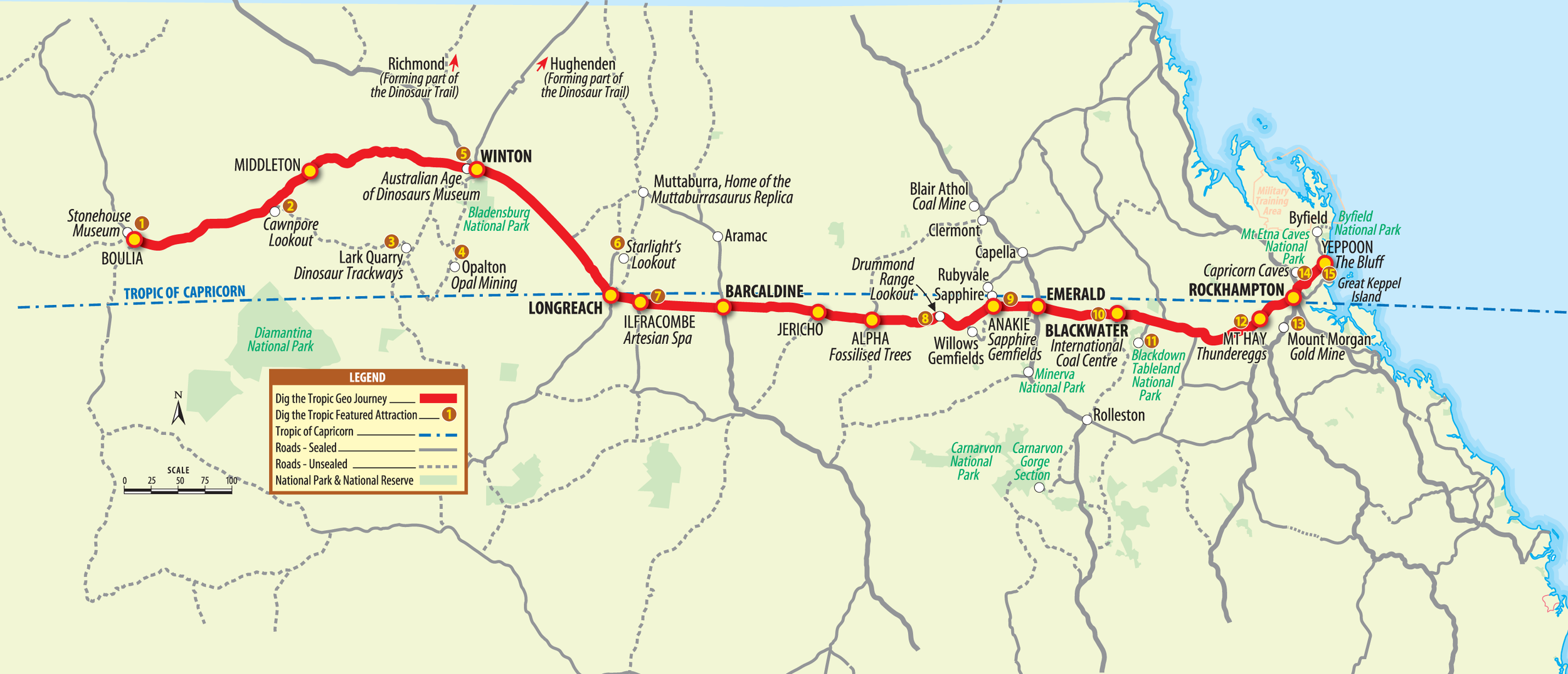
Mount Morgan
Mount Morgan
S 23’009.79, E 142’29.761
Gold makes up only five ten-millionths of the Earth’s outer layer, however, incredible quantities of this precious metal have been mined on Queensland’s Tropic of Capricorn. Mount Morgan is home to one of the oldest mines in Australia, and provides evidence of the richness of the regional deposits. But how did the gold form, and why did it form here? Discover Mount Morgan’s incredible geo journey…
Mount Morgan’s Geo-Journey:
Hundreds of Millions of Years Ago… gold was brought to the outer layers of the Earth’s crust by ancient volcanoes along Australia’s eastern states. The drastic climate changes that followed weathered these primary gold deposits.
170 million Years Ago
Dinosaurs lived in the Mount Morgan area during the Jurassic and early Cretaceous periods. Plesiosaurs were powerful aquatic reptiles that propelled themselves through the area’s deep lakes, while three-toed theropods roamed the surrounding muddy terrain.
1870
William Mackinlay was the first to discover that the ironstone outcrop of the mountain was gold bearing.
Prospectors fossicking for alluvial gold in nearby gullies were unaware the source of their treasure waited not far away. Mackinlay had hoped to sell his knowledge.
1882
When the Morgan Brothers learnt of Mackinlay’s secret, mining began and Ironstone Mountain was renamed. Mining at Mount Morgan was to continue for around 100 years and included staggering gold, silver and copper excavation.
1953
Formations on the ceiling of the Mount Morgan caves were found to be 150 million year old theropod footprints. The footprints were originally made in soft mud which was then covered by fine sandstone. Erosion then removed the shale layer containing the footprints and exposed the casts of the feet in the overlying sandstone.
1965
Plesiosaur fossils were discovered 150 metres north of the Mount Morgan mine. They are the only known fresh-water Plesiosaur fossils that have been found in Australia and the size of the vertebrate suggests the reptiles were around 4.5 metres long.
1980s
After exhausting the ore body the mine closed, having produced 225 000 kg of gold, 50 000 kg of silver, and 360 000 tonnes of copper in total.
Today
What was once a large mountain is now one of the largest artificial holes on earth. It is over 2.5 km long and over 300 m deep. The Mount Morgan site now retains important heritage status and the surrounding area, including the river, is undergoing rehabilitation.
How can I experience Mount Morgan?
Mount Morgan Historical Museum:
Explore the collection of memorabilia and photographs that depict the booms and busts Mount Morgan has experienced. Casts of the plesiosaur fossils found in the Mount Morgan caves are also on display here.
3D movie carriage at the Mount Morgan Railway Museum:
Discovery of gold in Mount Morgan necessitated the introduction of a rail system up over the razor back. With a gradient of 1 in 16.5 the ABT system proved to be ideal. The rail carriage at the end of the platform is now home to a 3D movie that tells the story of the rack rail and its benefits to the new gold mine.
For more information
For more information about activities in Mount Morgan head to the Mount Morgan website (Phone: (07) 4938 2299).

